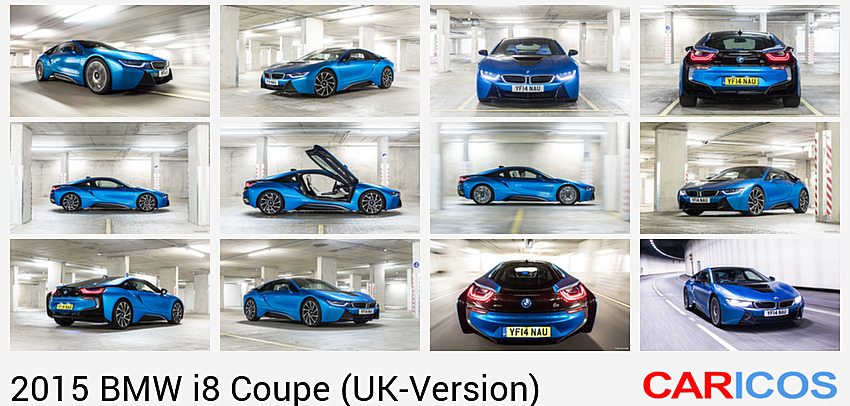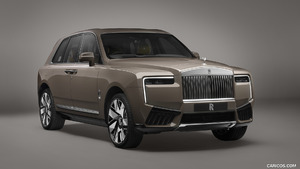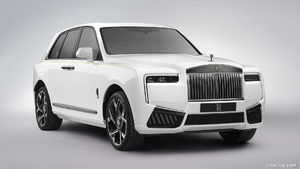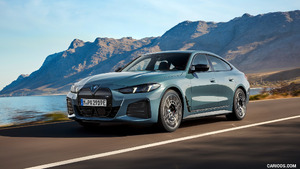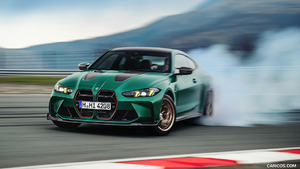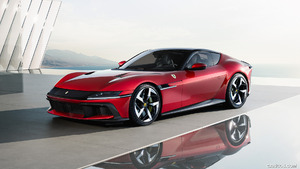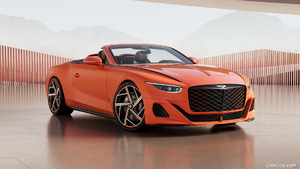BMW i8 Coupe (UK-Version)
Design
Visible efficiency with aerodynamic optimisation on a detailed level. The design of the BMW i8 brings together hallmark BMW dynamics, lightweight design and efficiency. The 2+2-seater is immediately recognisable as a BMW i model and a new-generation sports car. A length of 4,689mm, width of 1,942mm and height of 1,298mm give the BMW i8 typical sports car proportions. Its dynamic character is also reflected in its long bonnet, clearly visible aerodynamic aids, stretched roofline, short overhangs and long, 2,800mm, wheelbase. The car’s wide track (1,644 millimetres at the front axle, 1,715 millimetres at the rear) completes the powerful dynamic presence generated by the car’s proportions.
The structure of overlapping and interlocking surfaces also contributes to the unmistakable appearance of the BMW i8. This layering principle allows aerodynamic forms to be wrapped up in a progressively styled package, while powerfully formed wheel arches draw attention to the wide track of the BMW i8. The compact construction allows the front and rear sections of the car to be particularly low-slung and thus accentuate the car’s dynamically stretched flanks. The dihedral doors open forwards and upwards, adding intrigue to the sports car design of the BMW i8.
The black belt on the BMW i8 emerges in a “V” shape from the bonnet and extends back over the roof into the rear section of the car, where it frames the centre section of the rear bumper. At the front end, the black belt is framed by the body-coloured apron and side panels, while at the rear it is overlapped by the floating roof pillars, extending over the rear lights.
The front view of the BMW i8 exudes sporting ability. Large front spoiler air intakes generate a feeling of depth. The broad BMW kidney grille stretches over to the slim headlights, accentuating the width of the BMW i8 and its road-focused stance. The car’s full-LED headlights adopt the hallmark U-shape of BMW i models.
The rear of the car is bordered by the sculpted rear wheel arches. The sloping rear window opens, allowing easy access to the storage compartment located underneath. The rear lights, reflectors and rear diffuser form a single visual unit that strengthens the car’s powerful appearance. Like the headlights, the intricately designed rear light clusters also feature the characteristic BMW i U-shaped design. The rear indicators are integrated into the downward sweep of the roofline, above the rear light cluster. All of the lights on the BMW i8 are LEDs as standard.
The BMW i8 boasts a drag coefficient (Cd) of 0.26 and a fine aerodynamic balance. The low-slung bonnet, partially closed kidney grille, Aero Curtains in the front spoiler, sealed underbody, contoured side skirts, and the air ducts between the rear lights and roof frame allow the air to be channelled extremely effectively as it hits the car.
The large 20-inch comparatively slim wheels with their bespoke, aerodynamically optimised design also help to quell efficiency-reducing turbulence. Their effect is reinforced by diffuser inlet footplates positioned behind the front wheels and ahead of the rear wheels.
The paintwork on the BMW i8 can be specified in a choice of four colours, three of which have been created exclusively for BMW i. All the paint finishes provide a striking contrast to the black belt. Depending on the colour chosen, the accent surfaces on the side skirts, at the rear and on the BMW kidney grille surround come in BMW i Blue or Frozen Grey.
Inside the driver orientation, typical of BMW cockpit design, is complemented by progressive elements which highlight the sports car’s dynamic flair and light weight. The occupants sit low down, in traditional sports car style, in lightweight seats. The standard leather trim extends beyond the seat surfaces to parts of the centre console, instrument panel and interior door panels. The use of leather treated with natural substances underlines the sustainable character of the BMW i8 alongside its exclusivity and sporting allure. Exposed carbon-fibre-reinforced plastic (CFRP) sections of the passenger cell, visible around the entry apertures when the doors are opened, provide a reminder of the low weight of the BMW i8.
The instrument panel of the BMW i8, with its horizontal lines and a layered design, creates a light yet powerful impression while emphasising the width of the interior. The arrangement of the overlapping, three-dimensional segments is complemented by a contrast-rich colour scheme. The centre console is home to the gearshift lever, the controller for the iDrive operating system, the Auto Stop-Start button, the eDrive button and the Driving Experience Control switch. The iDrive system includes a freestanding 8.8-inch display with Professional Navigation as standard.
As standard, the BMW i8 features the Neso interior world. In this specification, the contrast between black surfaces in the cockpit and light Carum Grey leather surfaces emphasises the lightness and sustainability of this vehicle concept. The leather surfaces of the door and side trim are complemented by Sitka cloth accents made from recycled material.
The optional Carpo interior world is available in Ivory White or Amido Black. The naturally treated leather surfaces feature perforated elements and subtle contrast stitching, underlining the superior character of the material and workmanship involved. Painted surface elements on the instrument panel, door trim and centre console add the finishing touches.
In the optional Halo interior world top-quality leather surfaces combine with textile accents and contrast stitching in BMW i Blue, while dark Dalbergia Tan and light Carum Grey provide attractive contrasts. The accent ring for the leather steering wheel comes in BMW i Blue in the Halo interior world and in Satin Silver in the other variants.
The hybrid drivetrain
The BMW i8 embodies a revolutionary, future-focused interpretation of the driving pleasure, for which BMW is renowned. It was purpose-designed as a plug-in-hybrid sports car offering agile performance, near 50:50 weight distribution and outstanding efficiency. An exceptionally lightweight and aerodynamically optimised body – including a passenger cell made from CFRP – plus advanced BMW eDrive drive system technology, a compact, highly turbocharged 1.5-litre petrol engine with BMW TwinPower Turbo technology and intelligent energy management all come together to create an overall concept that represents a new landmark in the EfficientDynamics development strategy.
The BMW i8 is the first BMW production model to be powered by a three-cylinder petrol engine. This highly turbocharged unit is equipped with latest-generation BMW TwinPower Turbo technology with high-precision injectors positioned between the valves, along with VALVETRONIC. The low roll torque is further reduced by a balancer shaft, while a multi-stage damper integrated in the automatic transmission ensures very smooth and refined running at low rpm. This three-cylinder combustion engine in the BMW i8 develops 231hp and drives the rear wheels, while a maximum torque of 320Nm is available from 3,700rpm.
The car’s second power source is a 96 kW/131hp hybrid synchronous electric motor which sends its power to the front axle. The motor develops 250Nm torque from a standstill. As well as providing a power boost to assist the petrol engine during acceleration, the electric motor can also power the vehicle by itself with a range in everyday driving of up to 22 miles and a top speed of 75mph on electric power alone, drawing its energy from a lithium-ion battery. Developed by BMW Group, the high-voltage battery has a liquid cooling system, offers a maximum usable capacity of five kilowatt hours and can be recharged from a conventional household power socket, at a BMW i Wallbox or at a public charging station.
The battery can also be recharged via the electric motor on the overrun. The high-voltage starter-generator, responsible for starting the combustion engine, can also be used as a generator to charge the battery, the necessary power being provided by the BMW TwinPower Turbo engine. These various processes help to ensure that the BMW i8 always has sufficient energy on board to power the electric drive system. The rear wheels of the BMW i8 are driven by the petrol engine via a six-speed automatic transmission, while the front wheels receive their power from the electric motor via a two-stage automatic transmission. Combined maximum output of 362hp and combined peak torque of 570Nm provide all-wheel-drive performance which is as dynamic as it is efficient.
Utilising both power sources enables the sprint from zero to 62mph takes just 4.4 seconds, going on to an electronically limited top speed of 155mph. All the while combined fuel consumption stands at 135mpg and CO2 emissions come in at 49g/km.
On entering the corner, the power split is biased towards the rear wheels to improve turning precision. For more vigorous acceleration out of the corner, the powertrain controller returns to the default split as soon as the steering angle becomes smaller again.
Five chassis configurations
The BMW i8 offers the driver scope to adjust the drive and suspension settings of the vehicle, in order to adapt the driving experience to their individual preferences. As well as the electronic gear selector for the automatic transmission, the driver can also use the Drive Dynamic Control or eDrive button. It gives the driver five operating modes to choose from: COMFORT, ECO PRO, SPORT and eDrive for pure-electric driving – in combination with COMFORT or ECO PRO mode.
The Drive Dynamic Control switch on the centre console gives drivers a choice of two settings. On starting, COMFORT mode is activated, which offers a balance between sporty performance and fuel efficiency, with unrestricted access to all convenience functions. Alternatively, ECO PRO mode can be engaged. The powertrain controller coordinates the cooperation between the petrol engine and the electric motor for maximum fuel economy. On overrun, the intelligent energy management system automatically decides, in line with the driving situation and vehicle status, whether to recuperate braking energy or to coast with the powertrain disengaged. ECO PRO mode also programmes electrical convenience functions such as the air conditioning, seat heating and heated mirrors to operate at minimum power consumption. The everyday driving range of the BMW i8 on a full fuel tank and with a fully charged battery is in excess of 310 miles in COMFORT mode.
SPORT mode offers sequential manual gear selection and at the same time switches to very sporty drive and suspension settings. In SPORT mode, the engine and electric motor deliver extra-sharp performance, accelerator response is faster and the power boost from the electric motor is maximised. And to keep the battery topped up, SPORT mode also activates maximum energy recuperation during overrun and braking. If the battery is being recharged using the car’s kinetic energy, the electric motor’s generator function switches to a more powerful setting. At the same time, gear change times are shortened and an extra-sporty setting is selected for the standard-fitted Dynamic Damper Control and the Electric Power Steering.
The BMW i8’s ECO PRO mode can also be used during all-electric operation. The vehicle is then powered solely by the electric motor. Only if the battery charge drops below a given level, or under sudden intense throttle application (kickdown), is the internal combustion engine automatically activated. The high-end chassis and suspension technology of the BMW i8 is based on a double-wishbone front axle and a five-link rear axle, whose aluminium components and geometry are specially configured for intelligent weight savings. The Electric Power Steering offers easy manoeuvring in town and typical sports car-style high-speed steering precision, combined with particularly low energy consumption. Also standard is Variable Damper Control: the electronically operated dampers change their characteristics according to the selected driving mode to deliver the desired vehicle dynamics.
The DSC (Dynamic Stability Control) stability system includes the Anti-lock Braking System (ABS), Cornering Brake Control (CBC), Dynamic Brake Control (DBC), Brake Assist, Brake Standby, Hill-Start Assistant, Fading Compensation and the Brake Drying function. The push button-activated Dynamic Traction Control (DTC) system raises the DSC thresholds, allowing some controlled drive wheel slippage for easier start-off on snow or loose ground, or for extra-dynamic cornering.
The chassis components of the BMW i8 are defined by their weight-minimised construction. The car’s standard-fit 20-inch forged aluminium wheels have an aerodynamically optimised, lightweight design.
Construction
The BMW i8 has its own version of the LifeDrive architecture developed for BMW i that gives it a unique range of tools for combining intelligent lightweight design and safety – to the highest standard in each case. The horizontally split LifeDrive architecture consists of two separate, independent modules. The combustion engine and electric motor, battery pack, power electronics, chassis components, and structure and crash functions are arranged together in the aluminium Drive module, while the central element of the Life module is the 2+2-seater’s CFRP passenger cell. The vehicle structure and materials employed in the i8 represent a pioneering example of automotive construction and reinforce the position of the BMW i8 as the most progressive model in the sports car segment.
CFRP is the lightest available material that can be used in the construction of a car body without compromising on safety. One of the stand-out characteristics of this high-tech material is its hugely impressive torsional rigidity, yet it is also carries 50 per cent less weight than steel and is 30 per cent lighter than aluminium. The LifeDrive architecture and high proportion of CFRP and aluminium in the car’s construction allow a previously unprecedented dimension in weight optimisation.
The kerb weight of the BMW i8 stands at 1,490kg, and the LifeDrive architecture also has a positive effect on how this weight is distributed. The battery unit is positioned low down in a central position, helping to give the car a low centre of gravity and enhance safety accordingly. Indeed, the centre of gravity of the BMW i8 is less than 460mm from the ground, making it lower than any other current BMW Group model. And this, like the car’s almost exact 50:50 weight distribution, ensures excellent handling properties.
CFRP passenger cell: flexible in form, extremely strong in crash tests
The LifeDrive architecture also allows exceptional levels of freedom when it comes to body design. In the case of the BMW i8, the result is an appearance that faithfully reflects the car’s sporting characteristics, its innovative premium character and its groundbreaking technology. The impressive structural strength of the CFRP passenger cell allows particularly large door apertures, which in turn ensures comfortable access to the rear seats of the BMW i8. The structure of the distinctive doors is composed of a CFRP inner structure and an aluminium outer skin. This construction is 50 per cent lighter than its conventional equivalent.
In its dry, resin-free state CFRP can be worked almost like a textile, and as such allows a high degree of flexibility in how it is shaped. The composite only gains its rigid, final form after the resin injected into the lattice has hardened. This makes it at least as durable as steel, but it is much more lightweight. The high tear resistance along the length of the fibres also allows CFRP components to be given a high-strength design by following their direction of loading. To this end, the fibres are arranged within the component according to their load characteristics. By overlaying the fibre alignment, components can also be strengthened against load in several different directions. In this way, the components can be given a significantly more efficient and effective design than is possible with any other material that is equally durable in all directions – such as metal. This, in turn, allows further reductions in terms of both material usage and weight. The lower accelerated mass in the event of a crash means that energy-absorbing structures can be scaled back, cutting the weight of the vehicle.
Safety
The development of the LifeDrive architecture and the version of it used for the BMW i8 incorporates the latest safety and accident research and requirements of international crash test procedures. The high-strength passenger compartment teams up with the intelligent distribution of forces within the LifeDrive module to provide the cornerstones for optimum occupant protection. Even after the structurally debilitating offset front crash, with an impact speed of 40mph, the extremely rigid material used for the passenger cell maintains an intact survival space for passengers. The crash-activated aluminium structures at the front and rear end of the Drive module provide additional safety.
Impressive rigidity, combined with its ability to absorb an enormous amount of energy, makes CFRP extremely damage-tolerant. Even at high impact speeds it displays barely any deformation. As in a Formula One cockpit, this exceptionally stiff material provides an extremely strong survival space. Less body deformation occurs compared with comparable steel bodies. Furthermore, the doors can be opened without any problem and the interior remains largely free of intrusions.
Rescue scenarios were worked through and checked as part of the development process. In standard cutting tests, the process of rescuing occupants from a BMW i8 involved in an accident was, in various scenarios, even more straightforward than that for conventional vehicles. That is because body components made from CFRP are lighter and can be more easily cut than high-strength steels.
The impressive safety characteristics of CFRP also come to the fore in side impact scenarios. Despite the heavy, in some cases concentrated forces, the material barely sustains a dent, and passengers enjoy unbeatable protection. All of which makes CFRP perfectly suited for use in a vehicle’s flanks, where every centimetre of undamaged interior is invaluable. However, there are limits to what CFRP can endure. If the forces applied go beyond the limits of the material’s strength, the composite of fibres breaks up into its individual components in a controlled process.
In the Euro NCAP side impact test, in which a pole strikes the side of the vehicle dead centre at 20 mph, CFRP again demonstrates its extraordinary energy-absorbing capacity. The Life module absorbs the entire impact with minimal deformation, guaranteeing optimum passenger protection.
Occupant protection and standard safety equipment is of the same high standard as that in vehicles from all the BMW Group’s brands. Front airbags and side airbags integrated into the seat backrests, plus head/curtain airbags for both rows of seats, are all fitted as standard, as are three-point inertia-reel seatbelts including belt stoppers, belt tensioners and belt force limiters for all seats.
Optimum protection for the high-voltage battery
Crash-active aluminium structures in the front and rear sections of the vehicle provide unbeatable safety for the Drive module. In a front or rear-end collision, these absorb a large proportion of the energy generated. The battery, meanwhile, is mounted centrally in the underbody section of the car to give it the best possible degree of protection. Statistically, this is the area that absorbs the least energy in the event of a crash, and the vehicle shows barely any deformation here as a result.
The high-voltage system is designed to cope with accidents beyond the legal requirements, with the high-voltage battery including features that ensure its safe reaction even in situations such as this. The latest series of tests conducted by the renowned DEKRA E-Mobility Competence Centre were extremely thorough. The experts concluded that electric and hybrid cars with lithium-ion drive-system batteries are just as safe as vehicles with conventional drive systems. To ensure maximum safety in such a crash scenario, the high-voltage battery is disconnected from the high-voltage system and the connected components discharged when the passenger restraint systems are triggered.
Repair costs for the BMW i models are normal for their class
Tests by vehicle insurers and BMW Accident Research show that accidents primarily result in minor damage. In around 90 per cent of all recorded accidents involving conventional vehicles, the damage sustained is to the outer skin. The BMW i8 takes account of this and is equipped with screw/clip-on plastic plating all around. Minor bumps are absorbed without leaving dents, as usually occurs with metal parts, and damage to the paint does not lead to corrosion.
If a section of the external skin needs to be replaced, this can be carried out quickly and economically. Overall, the accident repair costs are at a comparable level to those for conventional BMW models.
“Cold” repair methods for aluminium parts, time-saving repairs for CFRP components
Repairs to the aluminium structure of the Drive module (welded as part of the series production process) are carried out using the “cold” methods of bonding and riveting. These methods have been in successful use in BMW workshops since 2003.
The reparability of the Life module’s CFRP structure was a priority in the development of the vehicle concept. The required side sill component is manufactured to fit and then installed on the damaged vehicle. The new part is bonded to the separation points using repair elements.
Any authorised BMW i dealer can repair the outer skin. However, due to the product-specific features of the LifeDrive module, there will be repair centres in which specialised employees take care of vehicles with damage to the aluminium or CFRP structure.
Revolutionary lights
The slim headlights of the BMW i8 team up with the BMW kidney grille to form a horizontal unit emphasising the car’s width. The plug-in hybrid sports car is fitted as standard with powerful and energy-efficient full-LED headlights. In their lower section, the light sources are framed by a U-shaped bar into which are integrated the daytime driving lights, sidelights and direction indicators. The intricately designed rear light clusters also feature the U-shape typical of BMW i cars. All of the lights on the BMW i8 are LEDs as standard.
The BMW i8 will also be the world’s first production vehicle to be available with headlamps featuring a new laser light concept. Whilst the basic version of the BMW i8 is equipped with high-intensity, energy-efficient full LED headlamps, the optional laser boost feature ensures a high beam range of up to 600 metres. This means that the already high illumination range of the modern LED high beam is doubled. Thanks to the new laser technology, it is possible to increase energy efficiency by a further 30 per cent compared to already power-saving LED lights.
In addition to lowering power requirement, BMW Laser Light illuminates the road ahead with a significantly higher light intensity without heating up the surrounding area. Laser diodes are ten times smaller than conventional light diodes. They help to save not only available installation space inside the headlamp, but also weight. The size of the reflector surface can be reduced by a factor of up to ten vs. LED light. The height of the reflector has now been reduced from the previous 9 cm to less than 3 cm. The light of a laser headlamp is extremely bright, similar to daylight, which is perceived by the human eye as pleasant. Several high-performance diodes emit a strongly bundled beam via special lenses onto a fluorescent phosphorus substance inside the headlamp. This substance transforms the beam into an exceptionally bright white light that is ten times more intensive than conventional light sources. Due to their highly intensive and virtually ideal beam properties, laser diodes render the overall system even more efficient. In conjunction with the camera-aided digital high-beam assistant, dazzling of oncoming traffic or vehicles ahead is reliably eliminated.The BMW i8 has the future of light technology within the body of the future sports car.
The electric display
The fully digital instrument display fitted in the BMW i8 shows the car’s speed and driving status information in a format and colour selected to suit the current driving mode. SPORT mode brings traditional circular instruments for speed and rpm readouts. In COMFORT mode a “powermeter” display replaces the rev counter to show the electric motor usage, while ECO PRO mode adds an efficiency display, which encourages drivers to maximise fuel efficiency through the use of the accelerator. The standard Professional Navigation system links up with a version of the proactive drivetrain management system specifically developed for the BMW i8. When the route guidance function is activated, the drivetrain management is configured to ensure the electric motor is employed as extensively and wisely as possible from an efficiency point of view. The system analyses the complete route and configures the drivetrain to run on purely electric power over low-speed sections. This ensures that the battery has sufficient capacity to cover the journey.
The performance characteristics of the electric motor and the capacity of the high-voltage battery have been configured to allow BMW i8 drivers to meet their urban mobility needs on electric power alone. Special displays in the instrument cluster keep the driver informed of the remaining range in all-electric driving modes. The map display function of the Professional Navigation system also contains a dynamic range display which shows the area the car can cover on electric power alone. The map view also displays the location of public charging stations.
BMW ConnectedDrive on the i8
As well as the Professional Navigation system, standard specification for the BMW i8 also features a cruise control system with braking function, front and rear Park Distance Control (PDC) and Head-up Display.
The standard BMW Head-up Display projects important driving data onto the windscreen. Information including the car’s speed, status alerts from the driver assistance systems, Check Control messages, speed limits and overtaking restrictions can all be displayed in the driver’s direct field of vision. Driving Assistant with Surround-view, Speed limit display and High-beam Assistant is optionally available and utilises the exterior cameras on the car to enhance safety and reduce the risk of potential collisions. Included within this package are: Rear view camera, Surround-View, High Beam Assistant, Forward Collision Warning, Pedestrian Protection, City Collision Mitigation, Speed Limit Info and No Passing assistant.
360° ELECTRIC
The BMW i8 offers a whole new approach to personal mobility courtesy of the new 360° ELECTRIC portfolio. Within this portfolio, BMW i brings together a wide range of innovative products and services that make electric car ownership an easy and satisfying experience, offering services including home charging and access to a continually expanding network of public charging points. Other benefits include networked navigation including dynamic range mapping, efficient ECO routing, and access to a range of Electric Packages helping to provide flexible mobility.
A SIM card, fitted as standard in the BMW i8, is the key that unlocks the BMW ConnectedDrive services which offers navigation services developed to enhance electric mobility, as well as the more familiar features. Drivers can use the BMW i Remote app to share information with their car at any time using their smartphone. This enables features such as the pedestrian navigation function that guides the driver from parking place to final destination and back. BMW ConnectedDrive also offers unique intermodal route guidance as a world first, which incorporates local public transport connections into journey planning, available from 2014.
Charging the BMW i8 in the UK
The BMW i8 comes as standard in the UK with AC Charging which sees a 3.7kW charge power up the BMW i8 battery from zero to 80 per cent within two hours. This can be performed by the optional BMW i Wallbox. The exclusive Wallbox has been created to give customers a comprehensive and premium sustainable mobility experience.
This equipment must be installed by a qualified electrician so a home survey, delivery, fitting and maintenance package for the BMW i Wallbox is available through Schneider Electric, while the installation service is managed by BMW and customised to customer’s specific requirements. Additional “renewable” power options will be offered via selected BMW i partners, for emission-free home charging. A seven day timer allows the car to be charged at night when renewable energy makes up a higher proportion of the energy supply and demand is at its lowest. AC Charging is also the most widespread public charging option in the UK.
As part of a £37 million package of investment in electric vehicles in the UK, the government offers a 75 per cent grant across the United Kingdom for the provision of domestic charging points that includes the BMW i Wallbox, bringing the installed cost down to £315**. The BMW i8 is engineered to meet standard industry specifications for charging compatibility.
For public charging BMW will offer its customers access to BMW ChargeNow, a unique service giving BMW customers in the UK cashless access to the largest nationwide network of public charging stations with a single card – the BMW i ChargeNow card. Charging stations in the ChargeNow network are displayed, along with their live availability, on the BMW ConnectedDrive services page in the navigation unit. Payment is a £20 annual fee, with pay as you go access, allowing customers complete control of their charging account. Customers will also receive an itemised monthly statement and have the ability to access their account information online at any time.
The new BMW i8 will be supplied with a standard 10amp/2.4kW five metre charging cable to enable charging from a 3-pin socket with a zero to 80 per cent charge in under three hours.
Complete mobility for the future
In the UK, 47 BMW dealerships have been appointed i agents, although the entire network can handle the servicing needs of the i8.
A range of Electric membership packages, including ChargeNow, BMW Access and Maintenance, will offer a flexible approach to electromobility from launch.
Taxation benefits
The BMW i8, like the BMW i3, is eligible for a host of government-backed grants and tax breaks due to its zero emissions powertrain. The BMW i8 also benefit from a zero road fund licence charge and is exempt from the London Congestion Charge.
Louis Vuitton tailor-made luggage set for BMW i8
Louis Vuitton has partnered with BMW to create a tailor made luggage set for the BMW i8. The collection of two travel bags, a business case and a garment bag have been tailor made to fit perfectly into the interior of the plug-in hybrid.
The carbon-black of this luggage range matches the colours of the BMW i8. Its sophisticated look comes courtesy of the unmistakable chequered Damier pattern – a Louis Vuitton hallmark – and a laser-etched Louis Vuitton signature. Black and electric blue used in the microfibre lining take their cue from the trademark brand colours of the BMW i8 and bag handles are made from dyed natural leather, a sign of Louis Vuitton quality. All items in the collection come with leather name tags and the iconic Louis Vuitton padlock, with the exception of the garment bag.
Inspired by the visionary design of the BMW i8, the bags and cases – like the sports car’s innovative passenger cell – are made entirely from carbon fibre. This particularly lightweight yet extremely sturdy high-tech material has been used by Louis Vuitton to create a special textile. It provides robustness and strength, and as such is made for the rigours of travel.
The exclusive luggage pieces created by Louis Vuitton fit snugly into the BMW i8. The Weekender GM i8, with both hand and shoulder carry straps, is custom-designed to go into the boot, while the Garment Bag i8is a perfect fit for the rear shelf of the BMW i8. The sturdy hardshell Business Case i8 which is also ideal for carrying laptops, matches the shape of the rear seats; while the small Weekender PM i8 is designed to rest on its surface.
The Louis Vuitton luggage set is available upon request from Louis Vuitton stores worldwide.

